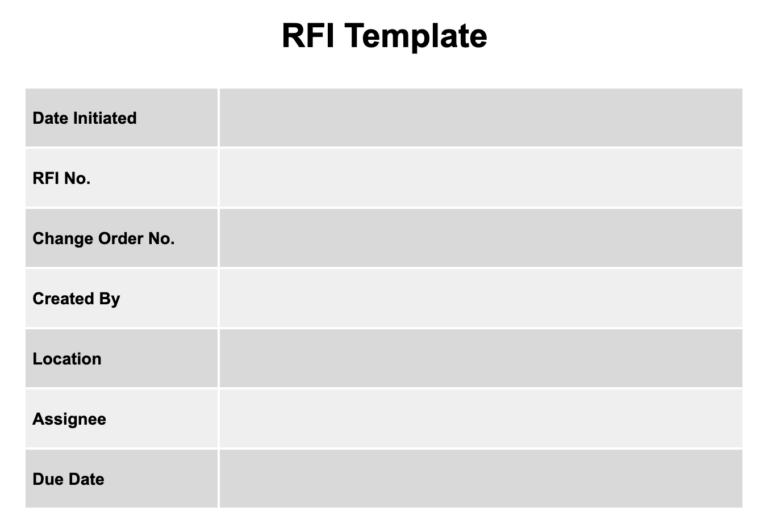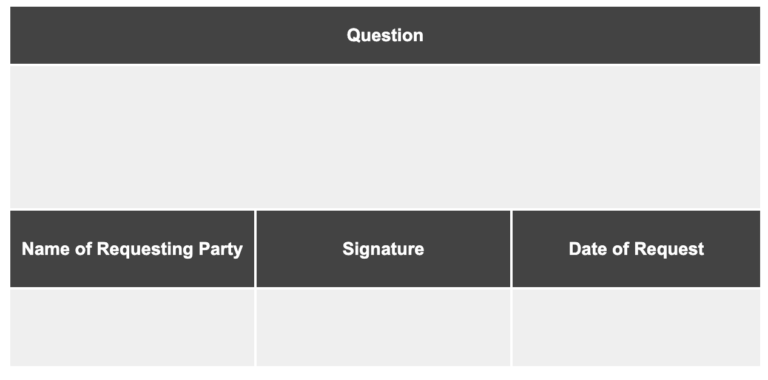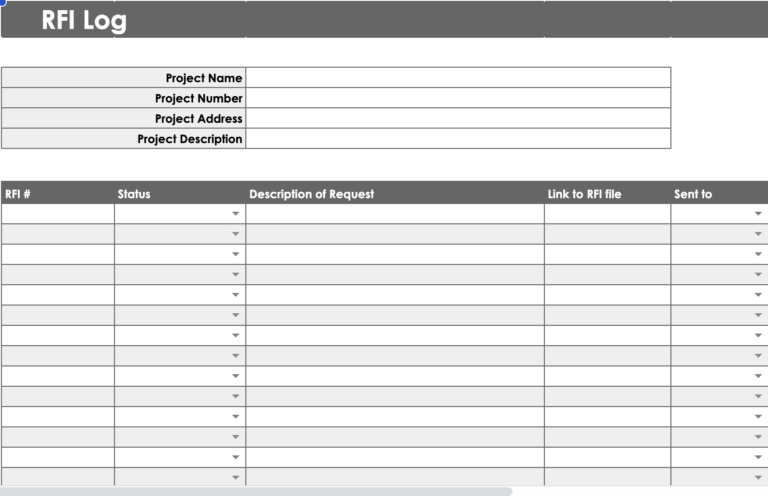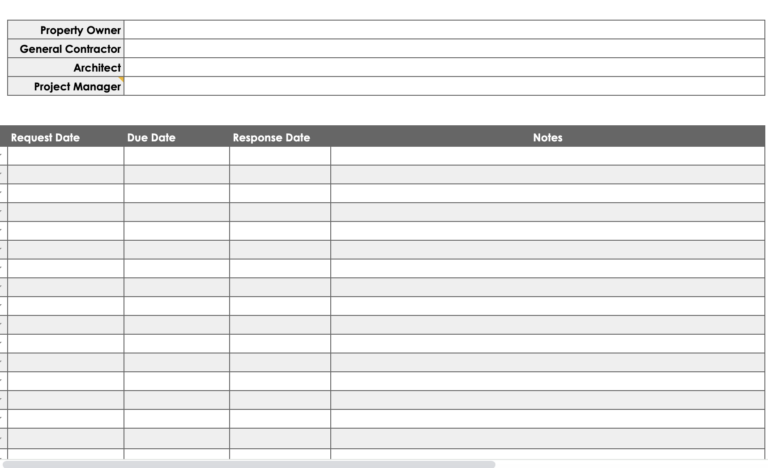— 5 min read
Free RFI Templates for Construction



Last Updated Nov 11, 2025

Anthresia McWashington
Content Manager
20 articles
Anthresia McWashington is a Content Manager at Procore. She previously worked as an editor and reporter for Gulf Energy Information and Houston Media Group. She earned her BA in Communications and Journalism from the University of Houston. Anthresia loves track & field and practicing her French. She lives in Houston.

Fernando Munoz
Product Designer
Fernando is a Product Designer at Procore. Previously, he worked as a Project Engineer and Project Manager at JE Dunn Construction. He also spent 5+ years as a fabrication and field engineer for CB&I, a global designer and builder of industrial storage facilities. Fernando holds a BS in Industrial Engineering from Louisiana State University and an MS in Civil Engineering, Construction Engineering & Project Management from the University of Texas at Austin. He lives in Austin, TX.

Kristen Frisa
Contributing Writer
112 articles
Kristen Frisa is a contributing writer for Procore. She also contributes to a variety of industry publications as a freelance writer focused on finance and construction technology. Kristen holds a Bachelor of Arts in Philosophy and History from Western University, with a post-graduate certificate in journalism from Sheridan College. She lives in Ontario, Canada.
Last Updated Nov 11, 2025

When questions or issues arise on a construction project, it’s important to make sure everyone is on the same page. A request for information (RFI) is a document intended to clarify details that are ambiguous or absent in the construction specifications and drawings.
Using RFIs, contractors can ask for details and check assumptions before completing any work, which can help to avoid errors, rework, delays and added costs.
RFIs promote open, transparent communication between contractors and the design team. Each RFI includes a deadline to receive the answer, so they also help keep projects on schedule. In an industry plagued by delays and poor communication, RFIs can be incredibly useful.
On this page, you’ll find free RFI templates for different scenarios that arise on a construction project, as well as some information about how to use them.
Table of contents
What is an RFI?
An RFI is an official document that a party involved in a construction project can use for requesting information or clarification related to the scope of work or contract documents of a project. When additional details are sought, RFIs are sent up from general contractors and subcontractors to the design team (engineer, architect, owner).
Contractors often use RFIs to clear up any details they feel unsure about in the project documents. They can also use RFIs to point out errors or missing information so that the design team can add it into the official record.
Downloadable RFI templates
These RFI templates were created by construction professionals to help contractors and project owners manage requests for information on a project. Project participants can use these forms to request additional information or clarify ambiguous specifications, and track the responses and status of each request.
Free Download
General RFI Template
Download and customize a general-use RFI template to request more detail or clarification about drawings, specifications, schedules — or get answers to any questions about a project.
- For use on projects when an RFI form is not specified
- Ready-to-use
- Designed specifically for construction



Free Download
RFI Log Template
General contractors and design teams use an RFI log to track RFIs submitted throughout the construction project, along with the responses received and the status of each request. Download and customize this RFI log template to track RFIs submitted throughout a project.
- Customizable to project requirements
- Ready-to-use
- Made by and for construction professionals



When to Use an RFI in Construction
Any party on a project can use an RFI for questions they want to ask officially, but there are some situations where RFIs are common. Below we’ll look at some common instances where an RFI is most useful.
Potential Communication Solutions
In construction, it’s not uncommon for gaps in communication between the design team and contractors to arise. An RFI can address any confusion or vagueness in plans to help contractors complete their scope of work with certainty.
For example: If a painting contractor doesn’t have the exact color depicted in the specs for an office wall, they’d submit an RFI to the design team to get the specific color. This eliminates the possibility of the contractor using the wrong shade of the color the design team wants.
Additionally, it can save contractors and the design team from the hassle of going back and forth to determine the correct color for the wall.
Preparing an Estimate
Contractors may also send an RFI when preparing an estimate. If they have a question about the work involved, such as an answer to the RFI may provide the information they need to prepare an estimate.
For example, if a contractor is preparing an estimate for the concrete scope of work on a project, but doesn’t know what type and strength of material to provide, they would submit an RFI to the architect or engineer asking for the specific details.
Questions During Bidding
During the bidding phase of a project, a contractor might use an RFI to request information about the work or materials required to complete the project. It’s difficult to prepare a fair and accurate bid without understanding the whole picture.
While RFIs related to the construction specs can be submitted during any phase of construction, it’s helpful to clear up the details during the bidding phase so contractors can put together an accurate bid for the work.
Potential Issues & Change Orders
When issues arise on a construction project, a contractor with foresight might send an RFI to the architect, owner or engineer requesting a solution to the problem. Often, the goal is to get an answer before the issue throws the project off schedule. If the solution to the problem involves a change to the scope of work originally outlined in the contract documents, a change order request may follow the RFI.
Free Course: Basics of RFIs
Learn the key principles of RFIs from the pros and earn continuing education credits from AIA.

What to Include in an RFI
RFIs aren’t highly regulated by the states in the U.S., so there are several different ways to create an RFI. There are, however, some basic elements that RFIs should include. These help keep the RFI streamlined and easy to understand — which is essential for receiving a timely answer.
- The requesting party name
- The responding party name (this is often a design professional, owner, or GC)
- The project name, address, and number
- A unique RFI number
- The date sent
- The due date for the response
- Drawing/specification number that the question relates to
- The question or problem
- The impact the problem may have on the schedule or budget
- A possible solution to the problem
These pieces of information will serve for nearly all construction RFIs. You can use them to ask for information or clarification that might result in changes to the scope of work.
Checking the Boxes
When it comes to executing a construction project efficiently, communication is key. An RFI helps close any gaps in information between contractors and the design team.
Clear and concise descriptions help ensure that contractors understand exactly what the design team has depicted in contract documents, and allow them to complete their scope of work as described.
Was this article helpful?
Thank you for your submission.
97%
3%
You voted that this article was . Was this a mistake? If so, change your vote
Scroll less, learn more about construction.
Subscribe to The Blueprint, Procore’s construction newsletter, to get content from industry experts delivered straight to your inbox.
By clicking this button, you agree to our Privacy Notice and Terms of Service.
Thank you!
You’re signed up to receive The Blueprint newsletter from Procore. You can unsubscribe at any time.
Categories:
Written by

Anthresia McWashington
Content Manager | Procore
20 articles
Anthresia McWashington is a Content Manager at Procore. She previously worked as an editor and reporter for Gulf Energy Information and Houston Media Group. She earned her BA in Communications and Journalism from the University of Houston. Anthresia loves track & field and practicing her French. She lives in Houston.
View profile
Fernando Munoz
Product Designer | Procore
Fernando is a Product Designer at Procore. Previously, he worked as a Project Engineer and Project Manager at JE Dunn Construction. He also spent 5+ years as a fabrication and field engineer for CB&I, a global designer and builder of industrial storage facilities. Fernando holds a BS in Industrial Engineering from Louisiana State University and an MS in Civil Engineering, Construction Engineering & Project Management from the University of Texas at Austin. He lives in Austin, TX.
View profile
Kristen Frisa
Contributing Writer | Procore
112 articles
Kristen Frisa is a contributing writer for Procore. She also contributes to a variety of industry publications as a freelance writer focused on finance and construction technology. Kristen holds a Bachelor of Arts in Philosophy and History from Western University, with a post-graduate certificate in journalism from Sheridan College. She lives in Ontario, Canada.
View profileExplore more helpful resources

RFIs: A Contractor’s Guide to Requests for Information
If a general contractor could add up all the minutes they spent waiting on a response to a request for information (RFI) throughout their career, they might have found that...

Estimate, Bid, Quote, or Proposal: What’s the Difference?
In construction, an estimate, bid, quote, and proposal can take on different meanings depending on who is using the term. Some construction professionals use the words “estimate” and “quote” interchangeably,...

Harnessing Smart Construction Technology for Future Growth
Augmenting human intelligence with smart technology in construction makes it possible to tackle the considerable challenges of building the structures society demands. To adapt to client expectations while maintaining profitability,...

Mastering Capital Project Risk Management Across the Project Lifecycle
Capital projects — construction of significant infrastructure such as highways, utilities, or large-scale structures like hospitals or office buildings — have long timelines and with longer construction time comes greater...
Free Tools
Calculators
Use our calculators to estimate the cost of construction materials for your next project.
Templates
Find a template to help you with your construction project tasks.
Material Price Tracker
Get the latest U.S. retail prices and view historical trends for common building materials.
Glossary
Explore key terms and phrases used in the industry.
